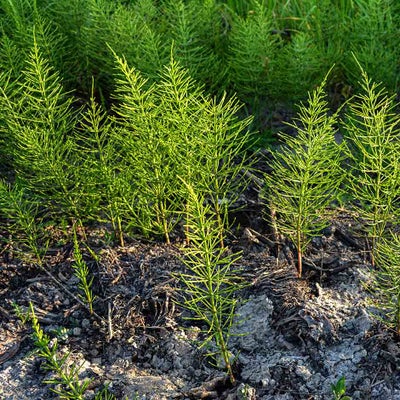
Quick facts
Horsetail’s botanical name is Equisetum arvense; it is sometimes called field horsetail or mare’s tail
It belongs to a very old group of plants, predating dinosaurs, and has been used in herbal remedies since ancient times
A variety of invertebrates feed upon and hide among its dense stems
Horsetail reproduces by spores but is usually spread by rhizomes (underground stems)
Rhizomes of established horsetail plants can grow to 2m (6½ft) deep underground
Controlling horsetail can be difficult, requiring patience and persistence
What does horsetail look like?
Horsetail has two distinct types of growth. The first type appears in early to mid-spring; these early shoots are curious-looking, light tawny brown, about 30cm tall, and easily mistaken for toadstools. Like other early plants (ferns, mosses, liverworts), horsetail reproduces by spores, and it is these early shoots that have spore-bearing cones (strobili) at their tips.
The second type of growth appears in late spring and grows throughout the summer. These shoots are green, reaching about 60cm in height, and en masse resemble a miniature conifer forest. The stems grow in segments, producing dense whorls of needle-like branches. They die back in autumn, leaving a system of dark and tubers underground, ready to produce new shoots again in spring.

Is horsetail a weed?
Although often viewed as a weed, horsetail does have an unusual beauty and is of interest as a ‘living fossil’, belonging to a group of plants that predate dinosaurs. Since ancient times people have used horsetail in herbal remedies to treat a range of ailments. It is also used to make an organic liquid fertiliser, with some claims that it has antifungal properties.
Did you know?
Horsetail also has the common name scouring rush, because it was used to clean wood and polish metal. High levels of silicon in the stems make them abrasive and therefore ideal for scouring surfaces.
Horsetail provides some benefits to wildlife too, with the Biological Records Centre listing six invertebrates that use it as a food source. Dense growth of horsetail provides habitat and shelter for various creatures, including ground-active invertebrates.
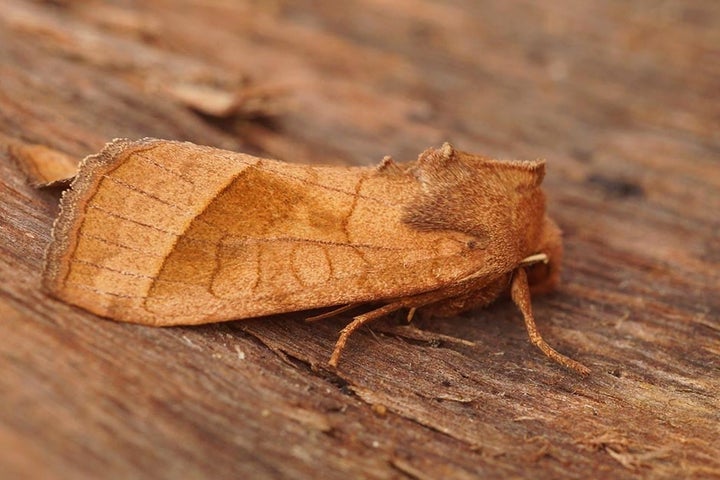
Large woody plants will be untroubled by an understorey of horsetail. However, the spreading habit and dense growth of horsetail make it unwelcome in areas where it will outcompete or smother smaller plants.
What is a weed?
The term ‘weed’ describes a plant that is growing where it isn’t wanted. Weeds usually thrive in average garden conditions, reproducing and spreading easily. It is up to you to decide what you call a weed and what you choose to retain or remove.
Frequently asked questions about controlling horsetail
Here are our answers to your most common questions about dealing with horsetail:
How invasive is horsetail?
Horsetail is a very successful plant, able to spread by spores and . The early shoots in spring produce spores that are dispersed long distances by the wind, but the spores are short-lived and need damp conditions to germinate and grow. Horsetail is more likely to spread by rhizomes, as these can grow in a range of conditions.
Its rhizomes spread slowly but can be up to 2m (6½ft) deep, making them difficult to remove, especially when intertwined with roots of other plants. They can easily cross boundaries, so horsetail may enter gardens by spreading underground from neighbouring properties. Small sections of rhizome can also regenerate, meaning horsetail is often spread unintentionally by chopping up rhizomes when digging or rotavating, or by moving plants, and soil containing pieces of rhizome.
Did you know?
Horsetail is very old; it belongs to a group of plants that date back to the Carboniferous period (325 million years ago) – a time before dinosaurs. Its longevity is admirable – having survived major asteroid impacts, seen numerous animal and plant extinctions, and established a native range covering most of the northern hemisphere!
Eradicating an established colony of horsetail from a garden or allotment can take many years, but gardeners shouldn’t despair if they discover their plot contains it, as there are several methods to manage its spread.
Do I need to get rid of horsetail?
No – it isn’t necessary to get rid of horsetail. When growing among trees, shrubs, or vigorous herbaceous , horsetail won’t cause any significant competition and its presence in parts of the garden increases and provides shelter and food for several invertebrates.
Many gardens contain horsetail, and it doesn’t necessarily make a garden less attractive or an allotment less productive, so long as its spread is managed. For example, some areas of RHS Garden Wisley contain horsetail. Here it is managed by hand pulling all the green stems in June, with a second weeding session in late summer to remove regrowth. This approach controls the horsetail enough for other plants to grow and produce an impressive display of flowers.
However, as its green stems can form dense ground cover from late spring to autumn, it is a good idea to control the growth of horsetail in parts of your garden where it might smother and outcompete , or smaller and less vigorous plants.
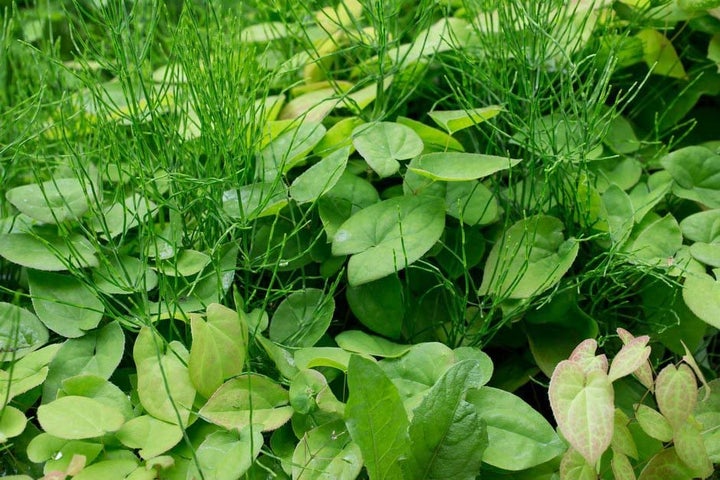
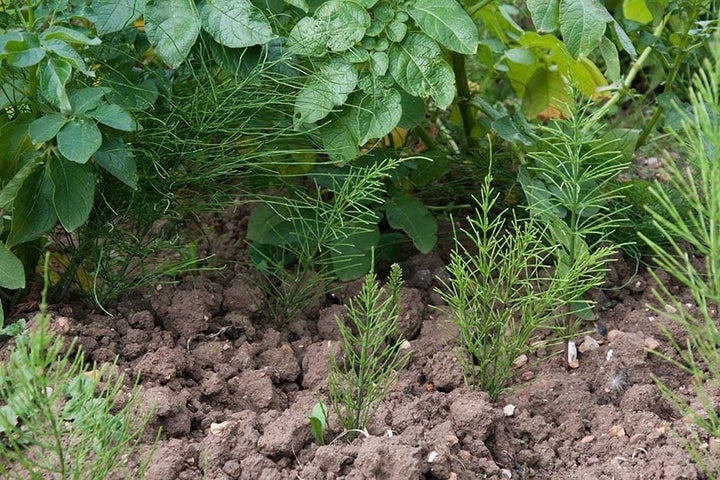
What is the easiest way to kill horsetail?
If you have horsetail growing where it is not wanted, there are several ways to control it:
- Pull or cut off new growth – remove shoots as soon as they appear above the ground to weaken horsetail. This will keep areas of soil clear, giving seedlings and other small plants a chance to establish.
- Fork out rhizomes – use a hand fork or border fork to remove rhizomes; doing this regularly will weaken growth and, if done over several years, can potentially eradicate horsetail. If growth is from small sections of rhizomes that have recently been introduced to your garden, then careful removal of rhizomes and close monitoring for regrowth can eliminate horsetail before it gets established.
- Smother plants – cover with a layer of compostable material, such as cardboard, and then a layer about 20cm (8in) thick of organic matter, such as or wood chips. Alternatively, use a heavy grade matting. This will block light and reduce growth, eventually causing the root system to die. Keep soil covered for several years, topping up the mulch layer when necessary.
- Shade out plants – plant densely with evergreen shrubs to weaken horsetail growing beneath. Horsetail thrives in open sunny positions and will lose vigour in shady conditions.
- Mow regularly – if horsetail appears in a lawn, mow regularly to weaken and eventually eliminate it. Laying turf over an area containing lots of horsetail and mowing it regularly is an alternative to covering the ground, and has the benefit of giving you an area of usable space during the process.
- Avoid disturbing the soil – horsetail can regenerate from tiny fragments of rhizomes, so avoid digging or rotavating the soil where it grows.
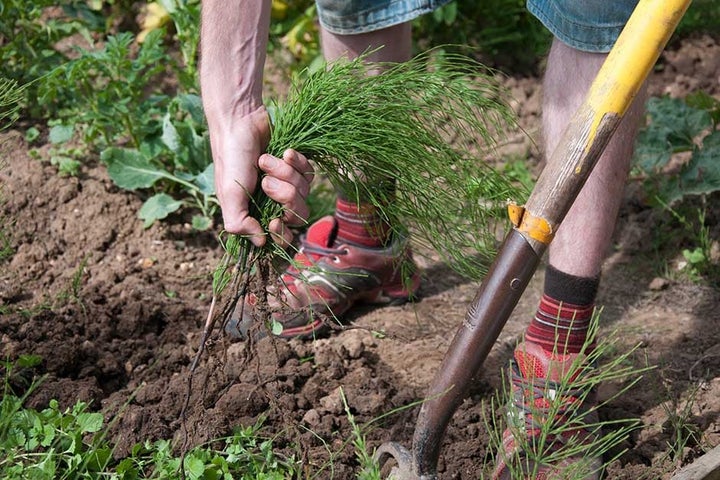
Top Tip
Don’t add horsetail to your home compost bin, as it may not reach high enough temperatures to kill it. Instead, put it in your council green waste recycling bin or take it to your local recycling site.
Should I use weedkiller?
No, as non-chemical control methods are effective, even if time-consuming, there is no need to use weedkillers. For more information, see our page on Weeds: non-chemical controls.
Using a systemic weedkiller (sometimes recommended for horsetail control) is not a quick or easy option. Due to horsetail’s scaly, moisture-resistant leaves and its deep network of roots/rhizomes, weedkillers available to home gardeners are often ineffective and may take numerous applications over several years to have any significant effect.
The RHS does not support the use of weedkillers and recommends that alternative control methods are used. However, we do note that when gardeners struggle to control plants with cultural methods, regulated weedkillers/pesticides for home gardeners are available for use legally. Garden centres and large retailers selling weedkillers have trained staff who can advise on suitable products for your needs.













